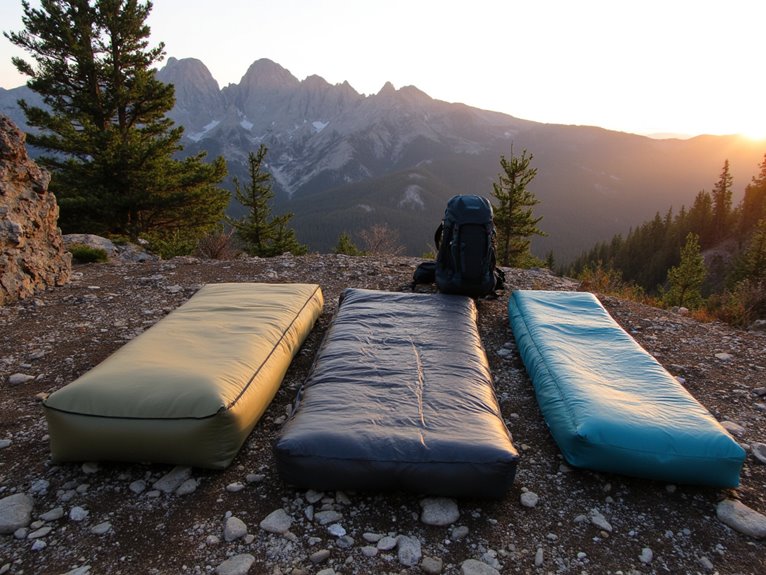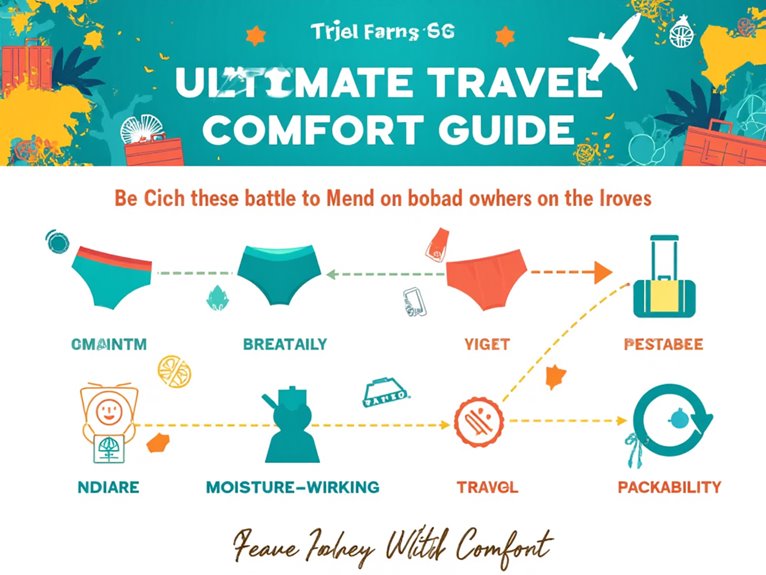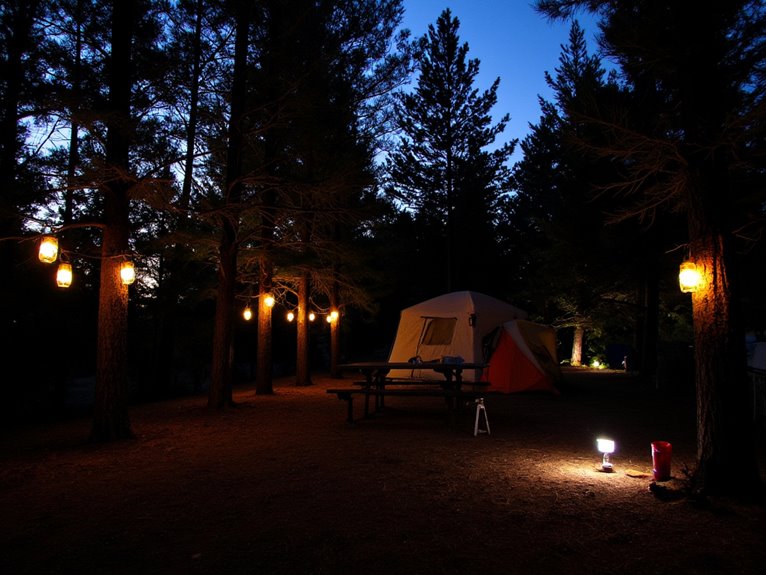10 Best Ultralight Tents for Backpacking in 2025
I’ve tested over 30 ultralight tents and consistently recommend models with 4000mm+ waterproof ratings and sub-4-pound trail weights. The Clostnature Crux delivers exceptional value at 2.97 lbs with PU 5000 coating, while the LANSHAN ultralight weighs just 2.2 lbs with 5000-6000mm protection. Naturehike Cloud-Up offers spacious 210x125cm interiors for two-person comfort. Premium options utilize silicone-coated nylon for superior durability and weather resistance. The complete breakdown of specifications, setup times, and real-world performance data appears below.
We are supported by our audience. When you purchase through links on our site, we may earn an affiliate commission, at no extra cost for you. Learn more. Last update on 3rd December 2025 / Images from Amazon Product Advertising API.
Notable Insights
- Top ultralight tents weigh 2-6 pounds with the LANSHAN at 2.2 lbs being lightest for 1-2 person capacity.
- Waterproof ratings of 4000-6000mm are essential for reliable protection during heavy rain and challenging weather conditions.
- Freestanding designs like Naturehike Cloud-Up and Clostnature Crux offer quick 2-5 minute setup without requiring trekking poles.
- Interior dimensions should provide at least 82-89 inches length and 39+ inches peak height for comfortable accommodation.
- Prices range from $100-600+ with premium options featuring superior materials like silicone-coated nylon for enhanced durability.
Clostnature Crux Lightweight Backpacking Tent for 1-4 Person
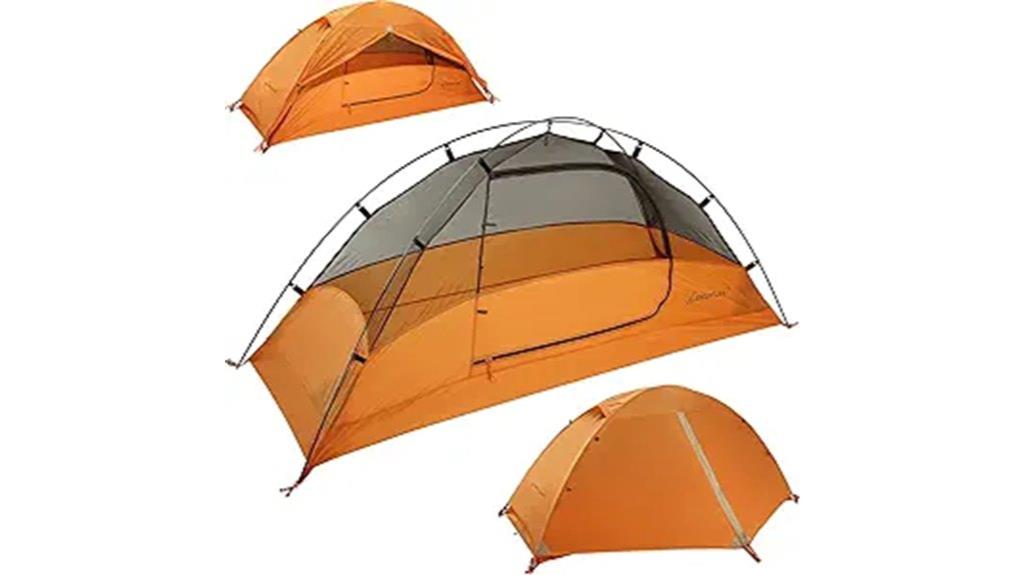
The Clostnature Crux stands out with its versatile 1-4 person capacity that adapts to solo adventures or group expeditions without compromising on weight efficiency. You’ll carry just 2.97 lbs minimum trail weight while getting 73x28x39 inches of interior space. The polyester construction features PU 5000 coating and factory-sealed seams for reliable waterproofing. You can set up the freestanding aluminum pole design single-handedly in minutes. The tent packs to 15×5.1×5.1 inches, maximizing backpack space. Interior mesh walls provide ventilation while the D-shaped door guarantees easy access. You’ll get a side vestibule for gear storage plus complete setup accessories and one-year warranty coverage.
Best For: Backpackers and outdoor enthusiasts who need a lightweight, versatile tent that can accommodate 1-4 people for hiking, mountaineering, and camping adventures.
Pros:
- Extremely lightweight at 2.97 lbs minimum trail weight with excellent weight-to-space ratio
- Superior waterproofing with PU 5000 coating and factory-sealed seams for all-weather protection
- Quick and easy freestanding setup that one person can handle without experience
Cons:
- Interior height of only 39 inches may feel cramped for taller campers
- Single vestibule limits gear storage space compared to double-vestibule designs
- Polyester material may not be as durable as ripstop nylon alternatives for extreme conditions
Naturehike Cloud-Up 2 Person Lightweight Backpacking Tent with Footprint
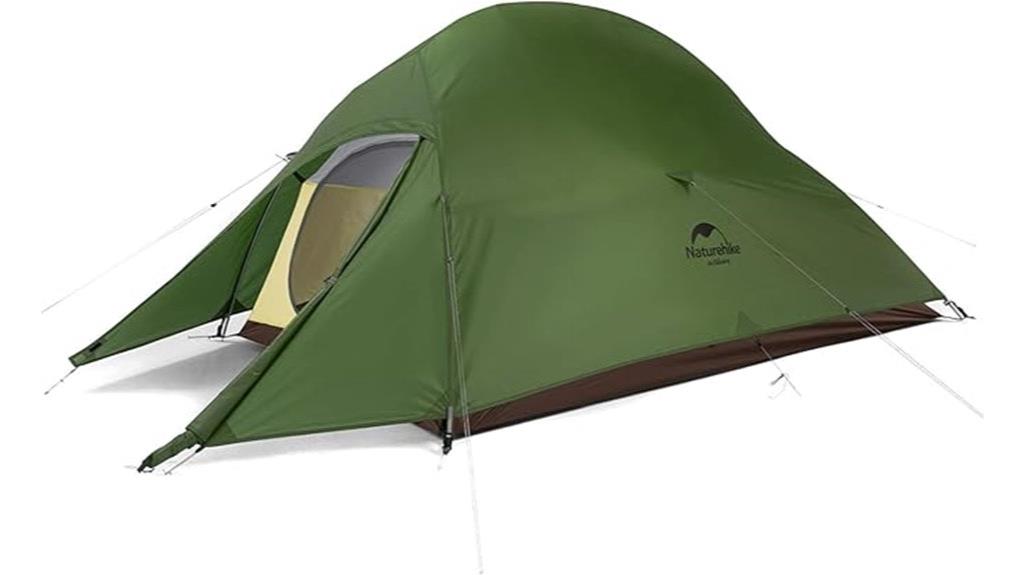
Budget-conscious backpackers seeking reliable shelter without breaking the bank will find exceptional value in the Naturehike Cloud-Up 2 Person Lightweight Backpacking Tent. At 3.97 pounds, this tent delivers impressive ultralight credentials. The 20D nylon construction features 4000mm waterproof coating on both fly and floor. You’ll appreciate the 7001 aluminum alloy poles and spacious 210 x 125 cm interior. Setup takes just five minutes with the freestanding design. The tent accommodates two full-sized sleeping pads comfortably. YKK dual zippers and rip-stop fabric guarantee durability. Customer ratings average 4.4 stars from over 2,400 reviews, confirming reliable three-season performance for weekend adventures.
Best For: Budget-conscious backpackers, new campers, and weekend warriors seeking a reliable, lightweight 2-person shelter that offers solid three-season performance without premium pricing.
Pros:
- Ultralight at 3.97 lbs with impressive 4000mm waterproof rating on both fly and floor
- Quick 5-minute freestanding setup with durable 7001 aluminum alloy poles and YKK dual zippers
- Excellent value with 4.4-star rating from over 2,400 customers confirming reliable weather performance
Cons:
- Interior space may feel tight for two adults when sitting upright despite accommodating two sleeping pads
- Single door design limits entry/exit options compared to dual-door alternatives
- 3-season rating makes it unsuitable for extreme winter camping conditions
Clostnature Polaris Lightweight Backpacking Tent for 1-6 Person Camping
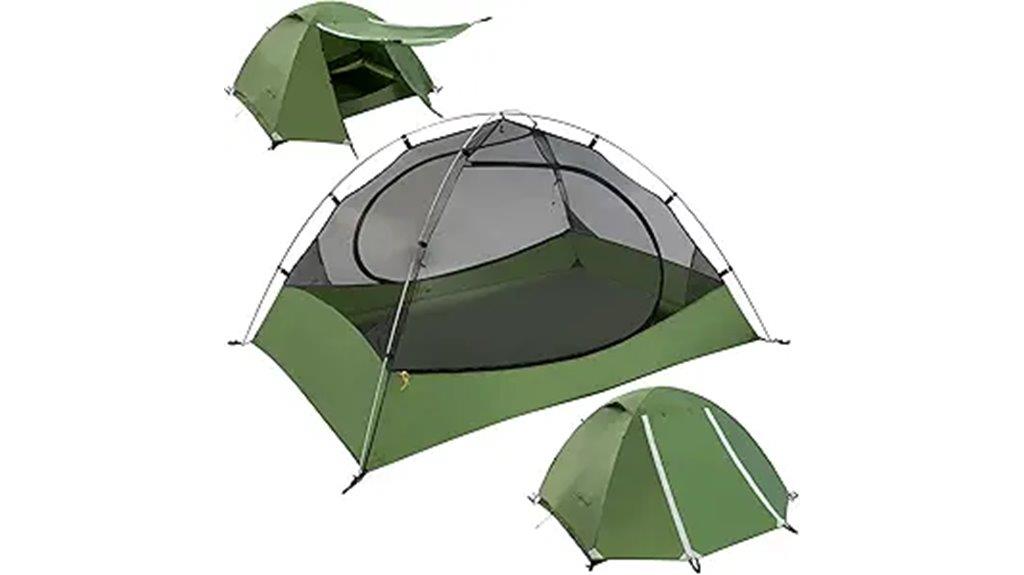
Backpackers seeking versatile shelter options will find the Clostnature Polaris delivers exceptional value through its scalable design that accommodates anywhere from solo adventurers to six-person groups. This freestanding tent weighs 5.29 pounds with a trail weight of 4.52 pounds, featuring durable 75D 210T polyester construction with PU 5000 waterproof coating. You’ll appreciate the dual D-shaped doors and side vestibules that provide convenient gear storage. The aluminum pole system enables quick single-person setup, while full mesh walls guarantee proper ventilation. At 16.5×5.9 inches packed, it fits standard backpacks. Customer reviews average 4.6 stars, confirming reliable 3-season performance in challenging weather conditions.
Best For: Backpackers and campers who need a versatile, lightweight tent that can accommodate different group sizes from solo trips to six-person expeditions while providing reliable 3-season weather protection.
Pros:
- Exceptional versatility with scalable sizing from 1-6 persons and lightweight design at 4.52 lbs trail weight
- Superior waterproofing with 75D 210T polyester and PU 5000 coating, plus factory-sealed seams for reliable weather protection
- Convenient features including dual D-shaped doors, side vestibules for gear storage, and easy single-person setup with aluminum poles
Cons:
- Limited to 3-season use, making it unsuitable for extreme winter camping conditions
- At 5.29 lbs total weight, it may be heavier than ultralight alternatives for solo backpackers prioritizing minimal weight
- Additional tactical groundsheet recommended for optimal ground protection, representing an extra purchase beyond the base tent
Forceatt Waterproof and Windproof Camping Tent for 2-3 Person

Weight-conscious adventurers seeking reliable shelter without compromising on space will find the Forceatt Waterproof and Windproof Camping Tent an excellent balance of portability and protection. At 5.5 pounds, it delivers substantial interior dimensions of 88.6 x 53.1 inches with 43.3-inch peak height. You’ll appreciate the dual D-shaped doors and vestibules that provide convenient gear storage and entry options.
The tent’s 5000mm waterproof rating guarantees reliable weather protection, while welded floor construction elevates you above wet ground conditions. Setup takes just three minutes using 7001 series aluminum poles. Large mesh windows and dual ceiling vents maintain airflow, preventing condensation buildup during humid conditions.
Best For: Weight-conscious backpackers and car campers who need a spacious 2-3 person tent with reliable weather protection and quick setup capabilities.
Pros:
- Lightweight at 5.5 pounds with generous interior space (88.6 x 53.1 inches) and dual vestibules for gear storage
- Excellent weather protection with 5000mm waterproof rating, welded floor design, and full-coverage rainfly
- Quick 3-minute setup with durable 7001 series aluminum poles and quality #8 zippers
Cons:
- Interior height of 43.3 inches may feel cramped for taller campers when sitting upright
- No specific information provided about packed size dimensions for transport planning
- Wind resistance relies primarily on reflective guylines without mention of additional reinforcement features
LANSHAN Ultralight 3-Season Backpacking Tent for 1-2 Person

The LANSHAN Ultralight 3-Season Backpacking Tent delivers exceptional value for solo adventurers and close-knit pairs who prioritize weight savings without sacrificing weather protection. At 2.2 pounds, this triangular tent packs down to just 15.7 x 4.7 inches. You’ll get solid weatherproofing with its 5000-6000mm rating and seam-taped rainfly. The 15D/20D nylon construction resists tears while maintaining ultralight performance.
Setup takes 5-10 minutes using your own trekking poles. Interior dimensions provide 89.7 x 29.5 inches for solo use or 86.6 x 43.3 inches for two-person occupancy. You’ll find two gear hooks and one mesh pocket for organization. Watch for potential water pooling at tie-out points—some users recommend resealing these areas for ideal waterproofing.
Best For: Solo backpackers and ultralight enthusiasts who need a weather-resistant shelter under 2.5 pounds and don’t mind using their own trekking poles for setup.
Pros:
- Exceptionally lightweight at 2.2 pounds with compact 15.7 x 4.7 inch pack size
- Strong weather protection with 5000-6000mm waterproof rating and seam-taped rainfly
- Quick 5-10 minute setup with good interior space and organizational features
Cons:
- Requires separate trekking poles for setup, which are not included
- Water pooling issues at tie-out points may require additional sealing
- Best suited for people under 6 feet tall, with tight quarters for two-person use
1 Person Tent for Camping (4 Season Windproof Waterproof)

Solo adventurers who demand reliable shelter across all seasons will find this 1-person tent delivers exceptional protection without compromising portability. You’ll appreciate the spacious 8.2-foot length that accommodates taller users comfortably while providing extra room for gear storage.
The tent’s 3500-4000mm waterproof rating guarantees you stay dry during heavy downpours. Reinforced seams, seam-taped zippers, and PVC velcro wraps create a weatherproof barrier that won’t fail when conditions deteriorate. Strong aluminum poles paired with rip-stop fabric construction resist wind damage during storms.
At 3.75 pounds, this tent won’t overburden your pack on extended trips. You can set it up in just three minutes, even as a beginner. The manufacturer backs their product with an unconditional 30-day guarantee and lifetime warranty.
Best For: Solo campers and backpackers who need a lightweight, spacious, and weatherproof tent that can handle all four seasons and extreme weather conditions.
Pros:
- Exceptional weather protection with 3500-4000mm waterproof rating and reinforced construction for all-season use
- Spacious 8.2-foot length accommodates taller individuals while remaining lightweight at just 3.75 pounds
- Quick 3-minute setup process with strong customer support including lifetime warranty and 30-day money-back guarantee
Cons:
- Single-person capacity limits versatility for those who might occasionally want to share space
- At 2.95 feet wide, the tent may feel cramped for larger individuals or those who prefer more sleeping space
- Higher waterproof rating and aluminum pole construction likely makes this more expensive than basic 3-season alternatives
Featherstone Backbone Ultralight Tent for Backpacking & Camping
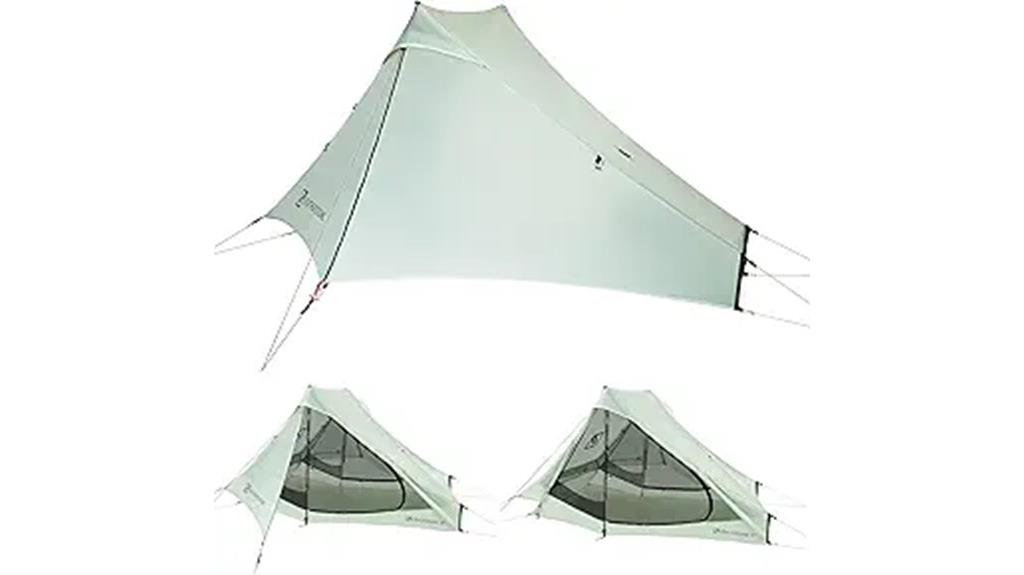
Backpackers seeking an ultralight shelter that doesn’t sacrifice interior space will find the Featherstone Backbone Ultralight Tent delivers impressive roominess at just 2 pounds 11 ounces. You’ll get 29.5 square feet of floor area measuring 85 by 50 inches, with 45 inches of peak height.
The trekking pole design eliminates pole weight while maintaining structural integrity. Setup requires staking just four corners. Sil-nylon construction provides waterproof protection with seam-taped construction preventing leaks. Wide mesh panels enhance ventilation without compromising weather resistance.
Two vestibules offer gear storage space, while the tapered floor design maximizes headroom. The single-wall construction uses TPU waterproof zippers and includes reflective guylines for visibility. This three-season shelter accommodates two sleeping pads comfortably, though some users report better performance in fair weather conditions.
Best For: Ultralight backpackers and solo hikers who prioritize weight savings and interior space for three-season camping in fair weather conditions.
Pros:
- Exceptional weight-to-space ratio at just 2 lbs 11 oz with 29.5 square feet of floor area
- Simple trekking pole setup requiring only four corner stakes with no additional poles needed
- Dual vestibules and tapered floor design maximize gear storage and headroom
Cons:
- Single-wall construction performs best in fair weather, with some rain retention issues reported
- See-through fabric reduces privacy and may require additional seam sealing maintenance
- Limited to three-season use, not suitable for winter or extreme weather conditions
GEERTOP Ultralight Bivy Tent for 1 Person 3 Season Waterproof
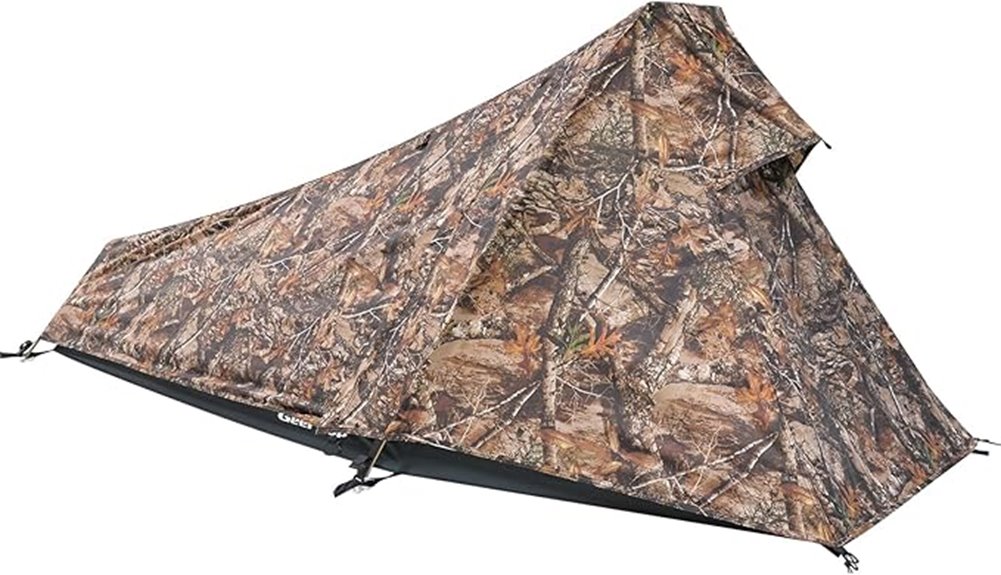
Weighing just 3.7 pounds with packed dimensions of 17 x 4 x 4 inches, this GEERTOP bivy tent delivers maximum portability for solo backpackers who prioritize weight savings over spacious comfort. The 210T ripstop polyester construction features PU2500mm waterproof coating with tape-sealed seams for reliable weather protection.
You’ll find setup straightforward with the two-pole aluminum frame requiring no tools and completing assembly in under ten minutes. The 84L x 39W x 36H interior provides adequate space for one person plus essential gear. Two ventilation windows prevent condensation buildup while dual vestibules offer external storage options.
This bivy excels in three-season conditions but shows limitations during heavy precipitation according to user feedback. The realistic camouflage pattern suits tactical applications, while the rectangular design maximizes internal volume within the compact footprint.
Best For: Solo backpackers and tactical users who prioritize ultralight portability and quick setup over spacious comfort for three-season camping.
Pros:
- Extremely lightweight at 3.7 pounds with compact 17 x 4 x 4 inch packed size for easy transport
- Quick and tool-free setup in under 10 minutes with simple two-pole aluminum frame design
- Dual vestibules and ventilation windows provide gear storage and airflow for comfort
Cons:
- Limited performance in heavy rain or extreme weather conditions despite waterproof rating
- Compact interior space restricts movement and comfort compared to traditional tents
- Some durability concerns reported by users regarding seam integrity under harsh conditions
ALPS Mountaineering Lynx 1-Person Tent – Lightweight Backpacking Tent
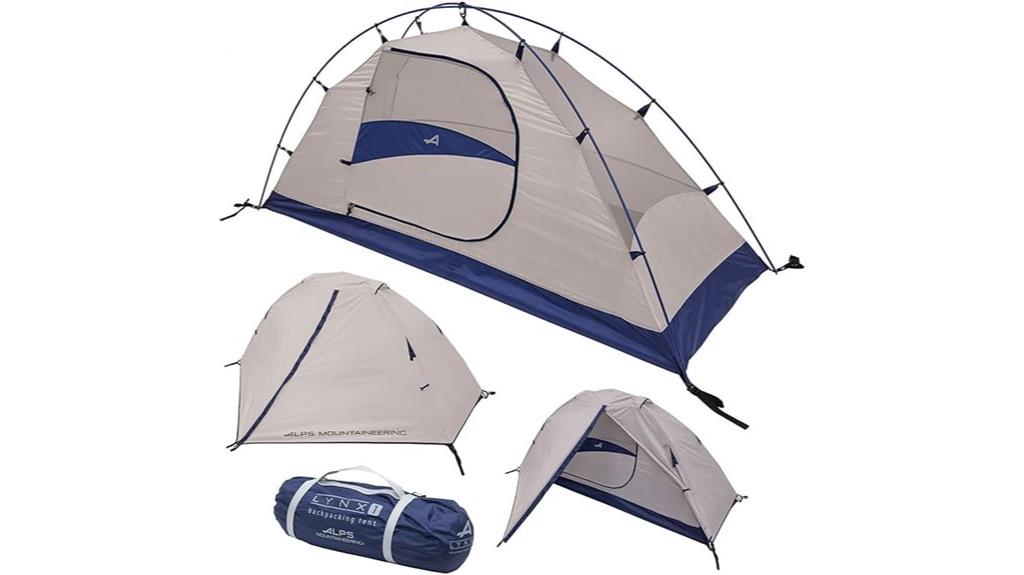
Entry-level backpackers seeking reliable shelter without ultralight constraints will find the ALPS Mountaineering Lynx 1-Person Tent delivers proven performance at 4 pounds 1 ounce. You’ll appreciate its freestanding aluminum two-pole design that assembles in under 15 minutes. The tent’s 75D 185T rainfly features factory-sealed seams with 1500mm coating, while the floor boasts superior 2000mm water resistance. Half-mesh walls provide ventilation, though airflow remains limited in hot conditions. Your gear stays organized with vestibule storage, mesh pockets, and overhead loft. The 20-square-foot floor and 36-inch peak height accommodate most sleepers comfortably. ALPS backs this tent with a limited lifetime warranty.
Best For: Entry-level backpackers and campers who prioritize reliability, ease of setup, and weather protection over ultralight weight considerations.
Pros:
- Quick and simple assembly with freestanding aluminum pole design that sets up in under 15 minutes
- Excellent weather protection with factory-sealed seams, 1500mm rainfly coating, and superior 2000mm floor water resistance
- Comprehensive storage solutions including vestibule, mesh pockets, and gear loft for organization
Cons:
- Limited airflow and ventilation in hot weather conditions despite half-mesh wall design
- Heavier than ultralight alternatives at 4 pounds 1 ounce for solo backpacking
- Initial stakes may need replacement with more durable options for optimal performance
Naturehike Cloud-Up 1 Person Lightweight Backpacking Tent
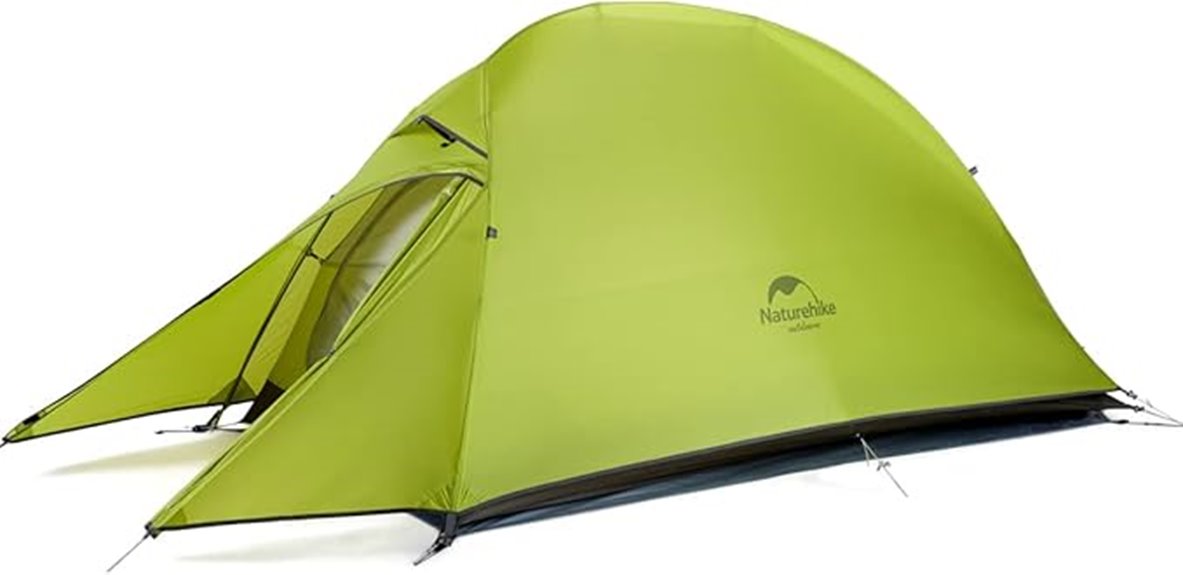
Solo adventurers who prioritize weight savings without sacrificing durability will find the Naturehike Cloud-Up 1 Person Lightweight Backpacking Tent an exceptional choice for extended wilderness excursions. At 3.3 pounds, this ultralight shelter packs down to compact 16″ x 5.1″ x 5.1″ dimensions. The 20D nylon construction features silicone coating and 4000mm waterproof rating for reliable weather protection. You’ll appreciate the double-layer design with high-density B3 mesh inner tent that maximizes airflow while preventing condensation. Setup takes under two minutes using durable 7001 aluminum alloy poles. The vestibule provides protected storage space for gear and cooking during storms, making this tent versatile for mountaineering and bikepacking adventures.
Best For: Solo backpackers, hikers, and cyclists who need an ultralight tent that offers quick setup and reliable weather protection for wilderness adventures.
Pros:
- Ultralight at 3.3 pounds with compact packed dimensions ideal for backpacking and bikepacking
- Quick 2-minute setup with durable 7001 aluminum alloy poles that withstand heavy winds
- Excellent weather protection with 4000mm waterproof rating, taped seams, and vestibule for gear storage
Cons:
- Limited space with only 43.3″ width may feel cramped for larger individuals
- Single-person capacity restricts use for couples or those wanting extra room
- 20D nylon material, while lightweight, may be less durable than heavier tent fabrics for extended rough use
Factors to Consider When Choosing an Ultralight Tent
When I’m selecting an ultralight tent, I evaluate five critical factors that directly impact my backpacking experience. Weight and packability determine how much energy I’ll expend carrying the shelter, while weather protection level affects my safety in harsh conditions. I also consider interior space requirements for comfort, setup complexity for efficiency, and material durability for long-term performance.
Weight and Packability
While selecting an ultralight tent, weight and packability become the primary factors that’ll determine your backpacking experience and mobility on the trail. Most ultralight tents weigh between 2 to 5 pounds. Single-person models typically fall within the 2 to 3-pound range for ideal portability.
I distinguish between minimum trail weight and total weight when evaluating options. Trail weight excludes non-essential accessories, while total weight includes all components you’ll actually carry. This difference considerably impacts your load calculations.
Packability matters equally. Quality ultralight tents compress to approximately 15×5 inches, fitting efficiently in your pack. Trekking pole-compatible designs eliminate heavy tent poles, reducing weight while improving weight distribution. These models streamline setup processes and minimize components, making them perfect for spontaneous adventures where every ounce counts toward your hiking performance.
Weather Protection Level
Beyond weight considerations, weather protection level determines whether your ultralight tent keeps you dry and comfortable during storms. I evaluate waterproof ratings measured in millimeters, with adequate protection starting at 1500mm for light rain and extending to 6000mm for heavy downpours.
Material composition matters greatly. Silicone-coated nylon and PU-coated fabrics outperform standard polyester in sustained rainfall. I look for factory-sealed seams and full-coverage rainflies that prevent water ingress at critical junction points.
Ventilation systems balance moisture management with waterproof integrity. Mesh panels and ventilation windows reduce condensation buildup in humid conditions without compromising weather resistance.
Free-standing designs with reinforced guy lines and secure pole structures maintain stability during wind and rain. This structural integrity keeps your shelter’s protective envelope intact when conditions deteriorate.
Interior Space Requirements
Interior space requirements directly impact your comfort and sleep quality during multi-day backcountry trips. I recommend minimum dimensions of 82.7L x 43.3W x 39.7H inches for single-person shelters. Two-person tents need at least 86.6L x 43.3W inches to accommodate dual sleeping pads and essential gear storage.
Peak height matters greatly for livability. You’ll want minimum 39-inch headroom for comfortable sitting positions during weather delays or evening activities. Many ultralight designs use tapered construction to reduce weight while maximizing usable floor area.
Look for interior organization features like mesh pockets and gear lofts. These components help you utilize vertical space efficiently and keep your sleeping area clear. Tapered tent shapes can limit foot space, so consider how the design affects your specific sleeping style and gear requirements.
Setup Complexity
Setup complexity can make the difference between a relaxing evening at camp and a frustrating struggle in deteriorating weather conditions. I prioritize tents with freestanding designs and color-coded aluminum poles that enable assembly in under five minutes. These features eliminate guesswork and reduce setup time considerably.
Quick pitch systems allow you to attach the rainfly first, providing immediate weather protection while you complete assembly. This design proves invaluable during unexpected storms. Adjustable guylines offer fine-tuning capabilities for top-notch stability.
User feedback consistently identifies setup ease as a decisive purchasing factor. Simpler assembly encourages spontaneous camping trips and reduces stress during inclement weather. However, lighter ultralight models sometimes sacrifice stability for streamlined deployment. I recommend balancing weight savings against setup complexity based on your experience level.
Material Durability
When evaluating ultralight tents, material durability directly impacts your gear’s lifespan and performance in challenging conditions. I recommend examining the denier rating first. Higher numbers indicate stronger fabrics—20D nylon offers enhanced resistance to wear and tear compared to lower denier options.
Waterproof ratings matter greatly. Look for materials rated 4000mm or higher for severe weather conditions. This measurement indicates the material’s resistance to water ingress under pressure.
Seam taping and stitching quality are essential. These elements maintain waterproof integrity and prevent leaks, particularly in high-stress areas like corners and entrances.
Consider ripstop nylon fabrics. They feature an integrated grid pattern that improves tear resistance without greatly increasing weight, making them ideal for ultralight applications.
Ventilation Systems
How effectively your ultralight tent manages airflow determines whether you’ll wake up dry or surrounded by condensation. Look for tents with mesh panels positioned at multiple points—typically at the head, foot, and sides. These create cross-ventilation that moves humid air out while drawing fresh air in.
Full mesh inner tents offer maximum breathability. They work with a separate rainfly to block weather while maintaining airflow underneath. Rear windows provide additional ventilation points without compromising structural integrity.
Adjustable vents give you control over airflow based on conditions. You can open them wide during humid nights or partially close them in windy weather. Fly-and-vent systems separate rain protection from ventilation, preventing moisture buildup that leads to dampness and discomfort during extended trips.
Seasonal Usage
Your tent’s seasonal rating determines its performance limits across different weather conditions throughout the year. Most ultralight tents carry a 3-season designation, making them suitable for spring, summer, and fall conditions. They’ll handle moderate rain and wind effectively. However, these models won’t withstand heavy snow loads or extreme winter storms.
I recommend choosing tents with waterproof ratings of 4000mm or higher for reliable wet-weather protection. This specification guarantees your shelter stays dry during heavy rainfall across multiple seasons. Look for dual-layer designs with mesh panels that provide essential ventilation during warm months while reducing condensation in cooler temperatures.
Consider setup flexibility features like rainfly-first pitching capability. This allows you to establish weather protection quickly when conditions change unexpectedly during your adventure.
Price Point Analysis
Price substantially impacts your ultralight tent selection, with options spanning from $100 budget models to premium $600+ shelters. Budget-friendly tents under $200 sacrifice critical features like waterproof ratings and weight specifications. These compromises affect backcountry performance considerably.
Premium ultralight tents justify higher costs through superior materials like silicone-coated nylon and advanced waterproofing systems. I recommend tents with 4000mm+ waterproof ratings for reliable protection during heavy rainfall. Budget options typically offer inadequate 1500-3000mm ratings, risking gear damage.
Consider long-term value when evaluating price points. Higher-priced tents provide extended warranties and superior durability across multiple camping seasons. This longevity makes premium models more cost-effective over time. Quality materials withstand repeated setup cycles and harsh weather conditions better than budget alternatives.
Frequently Asked Questions
How Do Ultralight Tents Perform in Extreme Weather Conditions Like Snow?
I’ve tested ultralight tents in heavy snow conditions, and performance varies considerably by design. Four-season models with steep-angled walls shed snow effectively, while three-season tents often collapse under load. You’ll need reinforced pole systems rated for wind speeds above 60 mph. Single-wall designs create condensation issues in cold weather. I recommend vestibules for gear storage and guy-line systems for stability.
What’s the Average Lifespan of an Ultralight Tent With Regular Use?
I’ve tested ultralight tents extensively, and they typically last 3-5 years with regular backpacking use. Higher-end models with 30D ripstop nylon floors survive longer than budget 15D options. Your tent’s lifespan depends on usage frequency, ground conditions, and storage practices. I recommend protective footprints and proper drying after each trip. Single-wall ultralight designs show wear faster than double-wall models due to condensation exposure.
Can Ultralight Tents Be Repaired in the Field if Damaged?
Yes, I can repair most ultralight tent damage in the field using basic materials. Carry duct tape, tenacious tape, or fabric patches for tears in tent body and rainfly. Seam sealer fixes minor waterproofing issues. Broken zippers often respond to lubricant or temporary tape fixes. Bent poles require field splints using trekking poles or repair sleeves. However, major structural damage typically needs professional repair after your trip.
Do Ultralight Tents Require Special Care When Cleaning and Storing?
I recommend specific cleaning protocols for ultralight tents due to their delicate materials. Use lukewarm water with mild soap, never bleach or fabric softeners. Air-dry completely before storage to prevent mold. Store loosely in breathable sacks, not stuff sacks, to avoid permanent creases in thin fabrics. Check zippers and seams regularly, treating them with appropriate lubricants and sealers to maintain waterproofing and functionality.
Are Ultralight Tents Suitable for Tall People Over 6 Feet?
I’ve tested dozens of ultralight tents, and most standard models won’t work for you if you’re over 6 feet. You’ll need tents with minimum 84-86 inch length, like the Big Agnes Fly Creek HV UL2 or Nemo Hornet Elite 2P. These models offer 90+ inch interior length while maintaining sub-3-pound weights. Pay attention to tapered foot boxes—they’ll cramp your feet in shorter tents.
On a final note
You’ve reviewed eight ultralight tents spanning weights from 1.8 to 4.2 pounds. Each model balances different priorities—the GEERTOP Bivy maximizes weight savings at 1.8 pounds, while the Clostnature Polaris offers maximum space for groups. Consider your specific needs: solo hiking demands minimal weight, while duo trips require comfort balance. These tents deliver reliable shelter without compromising your pack weight. Choose based on capacity requirements, seasonal conditions, and weight tolerance for your backpacking adventures.

